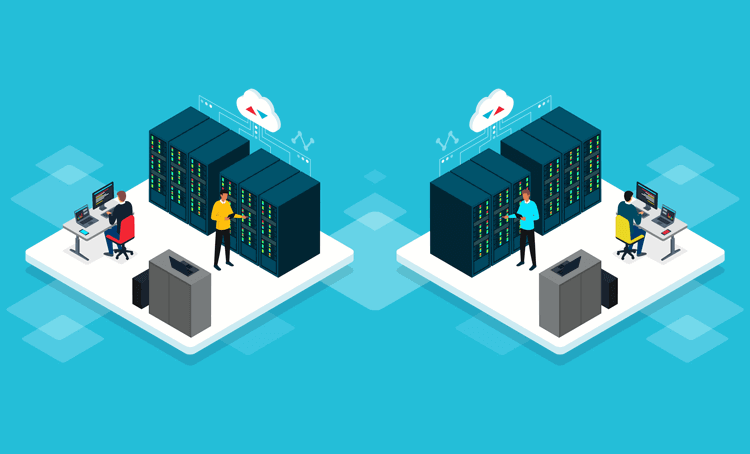Proactive IT Fully Explained: What It Is, Its Benefits, and 15 Top How To's
Many companies use some form of IT Service Management (ITSM), or have an IT department that is usually in-house or through a dedicated Managed Service Provider (MSP).
IT teams or MSPs can provide reactive or proactive IT support, or a mix of both.

Ideally, organizations need both types, and in this article we will go in-depth about Proactive IT support.
What is Proactive IT?
Proactive IT is the active monitoring of your digital environment that includes regular updates, pre-emptive security fixes, consistent secure backups, and a digital strategy roadmap.
On the other hand, Reactive IT is an IT team that waits for something to break and then fixes it. Also known as break-fix support and troubleshooting.
Support tickets come in from customers. They're assigned to the relevant team members depending on how serious/difficult they are to fix. These in turn work to fix what's broken in coordination with internal teams or third-party vendors.
In many ways, Proactive IT is the opposite of the traditional, reactive, break-fix approach. Proactive IT ensures that systems don't break, or at least 99% of breakdowns are avoided. Having clear digital roadmaps and transformative strategies also unlocks an enormous amount of IT value and efficiency. This is normally missed when a strategy is purely reactive rather than being proactive.
Benefits of Proactive IT
There are numerous benefits of having a Proactive IT system and support rather than a purely reactive model:
-
Minimum downtime: Downtime, planned or unplanned, is an expense that most businesses don't want or need. With Proactive IT, you can ensure this is kept as low as possible.
Without systems to provide redundancy and backups, unexpected IT downtime could prove very expensive. Large organizations can be looking at costs of up to $1-5 million per hour in the event of system-wide outages. This doesn't include potential penalties or legal fees in case of data breach or otherwise.
- Better productivity: With 24/7 monitoring of your digital environment, employee productivity is naturally improved. The number of support tickets can drop dramatically. This can help enable IT processes to work well rather than being something that causes stress, downtime, and unnecessary headaches.
- Enhanced security: With 24/7 monitoring of your digital environment, security improves too. There's much less chance of being caught unaware by a virus, bugs, or other security issues that can wreak havoc and cost an organization millions.
- Cost effectiveness: Reactive IT involves fixing something when it's broken. Isn't it better to ensure nothing breaks in the first place? Proactive IT pays for itself with IT strategies and an approach that prevents tech from breaking before it can cause significant problems.
Watch Our Proactive IT Comprehensive Guide Video
Now, let's take a look at how organizations can implement a proactive IT strategy with their in-house ITSM, outsourced MSPs, and SaaS vendors.
15 Top Ways to Implement Proactive IT
Here are 15 great ways to implement a Proactive IT strategy.
-
Implement Continuous Monitoring
The first step towards implementing a Proactive IT strategy is to have continuous monitoring tools in place at all times. These tools can be installed remotely, monitored by AI-based systems around the clock, and alert IT staff when something looks like it might break.
-
Employ Predictive Analytics
Another important step is implementing predictive analytics. Install these as part of a continuous monitoring system. This way, if traffic to a particular system, server, or database is unusually high, or a CPU/GPU is struggling to cope with demand it can be investigated right away.
It's a better approach than to be caught off guard when something breaks without knowing it was going to happen or understanding the root cause.
-
Automate Routine Tasks
Automate as much as you can. Use a proactive approach to IT to ensure that routine tasks for staff in every department and team are automated and managed effectively.
-
Establish Redundancy
Having redundancies is an essential part of every IT system. The last thing you need is for a critical system or server to break without any backups or anything to step in and ensure everything keeps working as it should.
For more information, read our IT Redundancy blog post.
-
Conduct Regular Vulnerability Assessments
You won't know how secure your IT systems are if you don't assess your IT security for vulnerabilities. What you don't know you can't plan for. Ensure a dedicated IT security assessment is included in your Proactive IT planning.
It's better to spend a few thousand each year getting everything checked over than a few million in an attempt to fix the problem after a security breach.
-
Stay Updated with Technology Trends
Similar to the above, seeing what's coming down the road and taking action is better than being caught unaware. Ensure your ITSM team or provider is continually monitoring new technology trends. They can even try out new software and systems so they can see what might fit better in your organization's tech stack. You'll find that proactive planning could give your team the edge over those who are caught by surprise by new innovations, such as generative AI.
-
Develop a Comprehensive Disaster Recovery Plan
Having an active and up-to-date Disaster Recovery Plan and IT Disaster Recovery Strategy is a mission-critical way to manage and mitigate risk. This should be an integral part of your organization's Proactive IT strategy, roadmap, and systems.
For more information, read our whitepaper on disaster recovery planning.
-
Implement Security Awareness Training
Viruses and cyberattacks aren't the most common form of getting money or customer data out of organizations anymore.
Now employees run the risk of being scammed with phishing or deepfake technology (using AI to trick employees into paying fake invoices is one of the most common uses).
Make sure, as part of a Proactive IT strategy, that employees are aware of the risks, know what to look out for, and most importantly, what to do in the event of an attempted security breach.
-
Monitor End-User Behavior/Employ User Behavior Analytics (UBA)
Installing User Behavior Analytics (UBA) is highly beneficial for proactively detecting security breaches and monitoring for unusual activity.
Unusual activity is normally a sign that a security breach is happening. It could be that a rogue virus has breached your security, perhaps via an employee being scammed with phishing or deepfakes. It happens more often than you'd think and can cost organizations millions.
-
Use Threat Intelligence Feeds
As part of proactive security, have systems that automatically monitor new threats and risks. Worried about deepfakes? Sign-up to threat intelligence feeds so that your team and front-line employees know what scams to watch out for.
-
Regularly Review and Update Security Policies and Procedures
- How robust are your security policies and procedures?
- How many employees are actively aware of them?
- Do your IT policies and procedures take into account new cyber security threats and risks?
If the answers to the above are vague then you need to invest time in ensuring that your Proactive IT security policies are, in fact, proactive.
Reactive IT security is more about bolting the stable door after the horse has escaped and jumped the fence.
Proactive IT security is about making sure the horse is secure in the stable and the fence can prevent it from escaping or anyone coming in and stealing it.
Have regular IT security policy update sessions to ensure they're in-line with modern threats and risks.
-
Implement Network Segmentation
On April 15, 1912, it was reported the White Star Line's RMS Titanic sank after striking an iceberg on the ship's maiden voyage from Southampton, England to New York City, United States. They indicated over 1,500 people died in the icy waters near Canada. The shipbuilders and architect of the ship, and shipping line itself, advertised it as being "unsinkable". It apparently wasn't.
Why did they say it sank?
Apart from the obvious factor of the iceberg itself, one of the reasons they said it sank was because the compartments that should have divided the vessel in the event of something catastrophic happening (e.g., hitting an iceberg) didn't go all the way to the top of the ship. Once water got to it, it was going to start sinking.
The same can be said of internal IT systems. Without watertight compartments, known as network segregation, vulnerabilities in one part of the network could bring everything crashing down. Learn from the Titanic story. Implement network segregation as part of a proactive and highly-secure IT system.
-
Regularly Update Software and Firmware
Regular updates of software and firmware are a necessary part of Proactive IT procedures. Without these regular updates, security patches and other plugins could be missing. This can risk putting the entire organization in danger or open to security vulnerabilities. Use automated monitoring to watch out for when updates need to be installed.
-
Establish Incident Response Procedures
Automated security systems should catch the bulk of security breaches. But what about the 1-5% that sneak through the net?
Make sure there's a clear incident reporting process that employees know how and when to use so that staff catch everything else.
The same process needs to apply to Reactive IT incidents. Even if Proactive IT catches 95% of issues before they occur, you'll need a reactive reporting procedure so that support tickets are logged the normal way and incidents are updated to the Proactive IT systems.
-
Promote Collaboration and Knowledge Sharing
And finally, ensure there's a proactive way for staff to share knowledge. Use this sharing as a way to proactively update internal knowledge bases and for knowledge management updates.
Proactive IT Future Trends
With technology changing as quickly as it is, Proactive IT designs and methodologies will also. These should help make Proactive IT systems even more robust. Here are a few trends:
-
Use of Artificial Intelligence and Machine Learning
Artificial intelligence (AI) and Machine Learning (ML) technologies can enable IT systems to analyze vast amounts of data in real-time. This can help better identify patterns and make predictions about potential issues before they occur. AI-powered systems can proactively detect anomalies and automate remediation tasks as well.
-
Expansion of Proactive IT Beyond Traditional IT Environments
Proactive IT is no longer limited to traditional IT infrastructure. It is being expanded to cloud computing and edge computing environments, and to Internet of Things (IoT) devices. These can bring a greater degree of proactive monitoring and management of IT systems.
Key Takeaways About Proactive IT
Investing in Proactive IT systems and processes is a smart move. Take your organization away from the reactive, break-fix approach and towards an approach that ensures ITSM teams are rarely caught unaware and having to react to something they didn't know was about to break.
It will save an enormous amount of time, money, and operational productivity.
Giva Can Help Streamline Your ITSM Processes
Manage your IT departments with Giva's Service Desk in the Cloud. Here are some key features:
- Giva follows the latest industry-leading ITIL® best practices including ITIL v4. ITIL is a best-practice framework or set of best practices that guide ITSM
- You'll be up and running in days, and your IT Service Management team can be trained in hours on our intuitive and friendly interface
- Giva provides video tutorials, self paced tours, quick start guides and FAQs
- Giva has the best real-time custom reporting and KPIs: Full color charts and graphs, which you can create, save, share and schedule delivery of standard and custom reports
Take your IT to the next level, and start a free 30-day trial today!





